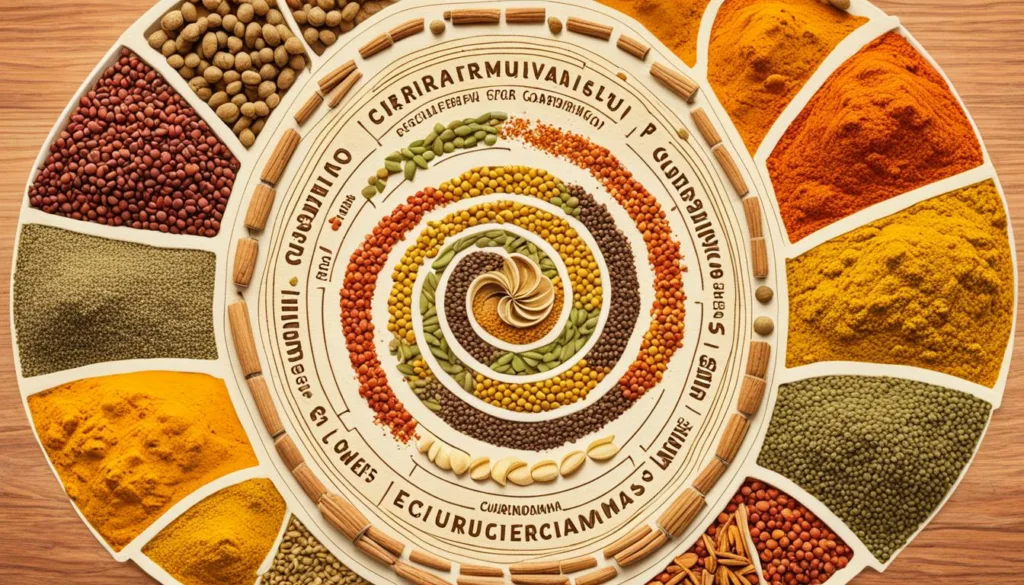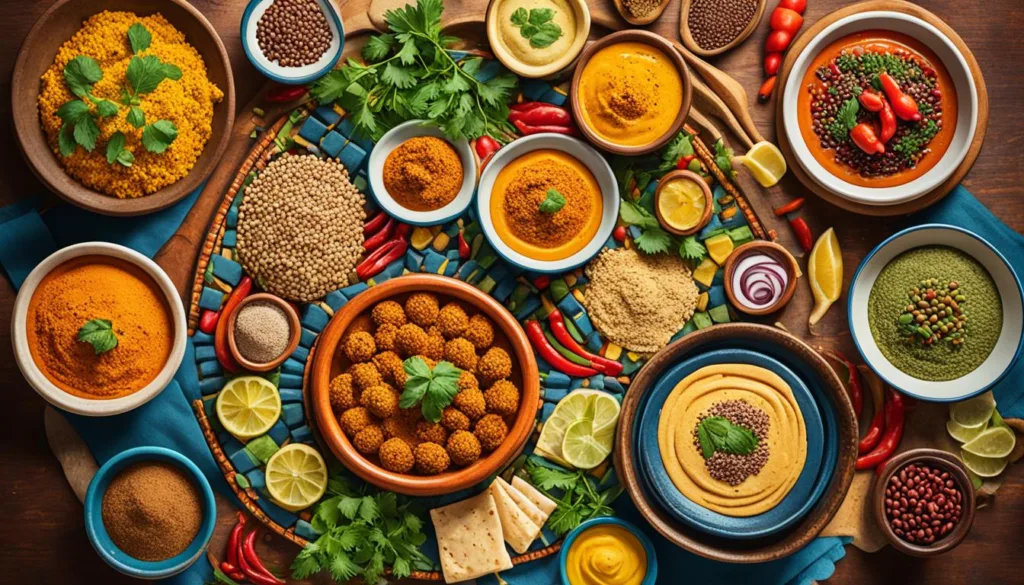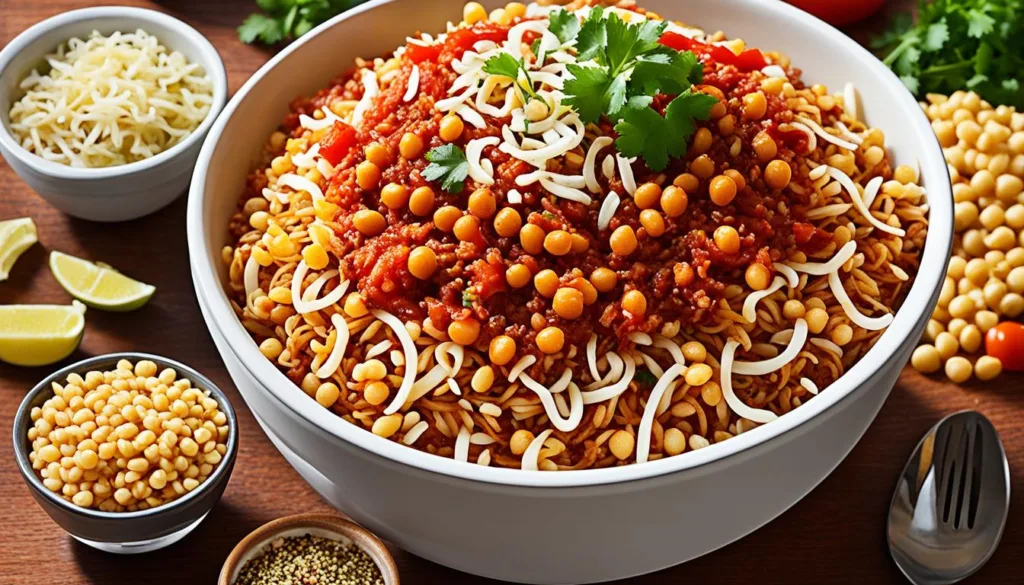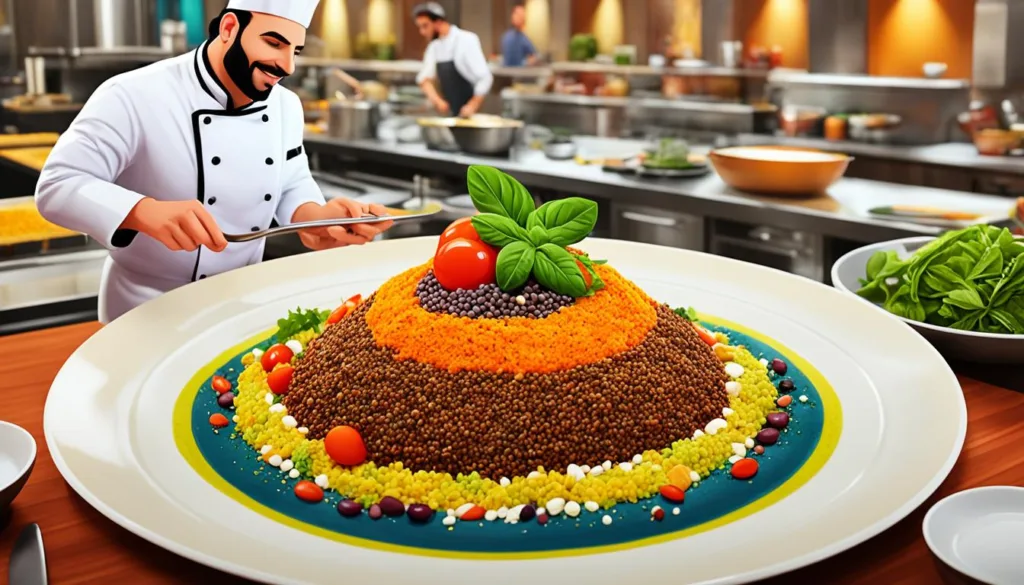Did you know that the Egyptian cuisine history spans over 5000 years, interweaving the palates and traditions of several ancient empires? An Egyptian Culinary Journey is not just about sampling food; it’s about uncovering the stories of the past, where every spice has a tale and every meal a heritage. The traditional Egyptian dishes we savor today are a symphony of flavors, perfected over millennia and reflective of Egypt’s dynamic history and social evolution.
The Egyptian dining table is a mosaic, bearing the legacies of Pharaohs, Greeks, Romans, Ottomans, and Arabs. By partaking in an Egyptian culinary tour, one embarks on a path that leads through time-honored dishes rooted deep within the folds of civilization. This tantalizing tour isn’t merely a quest for the exotic but a voyage back to the spice bazaars and Nile-side villages that have been essential to Egyptian society’s fabric. Exploring Egyptian cuisine is about embracing the crossroads of cultures that have tinted its culinary canvas with vibrant and delectable hues.
Key Takeaways
- Discover how millennia of diverse empires have shaped Egyptian culinary history.
- Embark on a taste-fueled journey that traces the origins of traditional Egyptian dishes.
- Learn about the ancient spice bazaars that contribute to Egypt’s distinguished culinary profile.
- Experience a rich sensory exploration that connects the bustling streets of Cairo with serene Nile villages.
- Understand the role of Egypt’s historical milieu in shaping a unique culinary tradition.
- Appreciate Egypt’s culinary adaptability that merges ancient traditions with modern practices.
The Essence and Tradition of Egyptian Cuisine History
The rich tapestry of Egyptian food culture is woven from threads that span millennia, intricately connected to the civilizations that flourished along the Nile. To explore Egyptian flavors is to embark on a voyage through time, where the taste of Egypt is a reflection of its enduring history and the melding of cultures that contribute to its culinary identity.
The Influence of Ancient Civilizations on Modern Flavors
Egypt’s strategic location at the crossroads of the ancient world significantly impacted its gastronomy, inviting a symphony of flavors from around the Mediterranean and beyond. The enduring influence of ancient Greeks, Romans, and later the Ottomans, can still be savored in contemporary dishes, infusing traditional Egyptian dishes with a remarkable depth of flavor.
From Aish Baladi to Shawarma: Continuity in Egyptian Gastronomy
A symbol of continuity in Egyptian dietary habits, Aish Baladi, the hearty Egyptian bread, remains a cornerstone of daily sustenance. Alongside, dishes such as Ful Medames and Shawarma serve as living history, depicting narratives of communal eating and culinary evolution. These staples have not just survived the test of time; they have become emblematic of the collective Egyptian food culture.
Spice Bazaars and Culinary Legacy: A Historical Perspective
The vitality of Egypt’s spice trade is encapsulated within its bustling bazaars. A stroll through any Egyptian spice market unfolds an aromatic landscape reminiscent of the tales once narrated by ancient traders. The fragrances of cumin, coriander, cinnamon, and nutmeg are not mere scents—they are the essences that chronicle Egypt’s role in the spice routes and contribute significantly to the taste of Egypt.
| Ingredient | Cultural Influence | Use in Traditional Dishes |
|---|---|---|
| Cumin | Ottoman Empire | Seasoning meat, soups, and stews |
| Coriander | Native to the region | Falafel, breads, and dressings |
| Cinnamon | Trade with the East | Roz Bel Laban (Rice Pudding) |
| Nutmeg | Arab Spice Trade | Kahk (Egyptian cookies) and desserts |
A Guide to Iconic Egyptian Spices and Ingredients
Delving into the intricacies of Egyptian spices and ingredients not only uncovers the subtleties of flavor that define one of the world’s most aromatic cuisines but also highlights the revered Egyptian cooking techniques that bring these ingredients to life. Each spice and ingredient is an ambassador of Egypt’s history, coming together to create a tapestry of tastes unique to the Egyptian palate. Let’s explore some of the cornerstones of this flavorful cuisine.
The blend of cumin, coriander, cinnamon, and nutmeg forms the backbone of many traditional recipes. From the succulent tenderness of slow-cooked lamb to the heartiness of beef stews, these spices complement the protein components gracefully. The grains, primarily rice and wheat, absorb these bold essences, enriching the dishes with depth and warmth.
- Cumin’s earthy notes accentuate the flavors of meats and pulses
- Coriander adds a lemony-sweet touch to sauces and side dishes
- Cinnamon infuses warmth in both savory entrees and sweet confections
- Nutmeg’s subtle woodiness enhances the creaminess of dairy-based sauces and desserts
The fundamental attributes of staple ingredients like yogurt, garlic, and onions cannot be overstated. Yogurt softens and balances the heat from the spices, garlic contributes a pungent kick crucial to many marinades, and onions form the aromatic base for a majority of dishes. The delightful piquancy of these alliums and the tang of fermented dairy are signs of a meal’s authenticity and homage to the agricultural richness of the Nile delta.
- Yogurt serves as a tangy marinade and a cooling side
- Garlic brings vigor and intensity to classic meat and vegetable preparations
- Onions offer a sweet foundation that interplays well with other flavors
By blending these components using timeless Egyptian cooking techniques, such as slow simmering in a Tagine or grilling over a low charcoal fire, the dishes achieve a harmony that tells stories of Egyptian culture. It’s a narrative filled with aromatic whispers of marketplaces and a testament to the culinary diversity that has evolved across centuries.

Whether one indulges in a savory stew infused with these spices or sips on a beverage tinged with the same aromatics, there’s no mistaking the presence of this rich culinary identity. It rings true in every morsel, in every sip, every memory that is lovingly crafted from an Egyptian kitchen. To experience Egypt fully, one must not only taste but also understand the subtle art of its spices and ingredients.
The Delectable World of Traditional Egyptian Dishes
Dive into the heart of Egyptian cuisine and discover the flavors that have enchanted diners for centuries. Authentic Egyptian recipes are not just about sustenance but carry forward traditions that have stood the test of time. In every spice and every bite, there’s a piece of history and a story to tell about traditional Egyptian dishes.

Delving into the Popularity of Koshari and Ful Medames
Among the mosaic of authentic Egyptian recipes, Koshari and Ful Medames emerge as favorites that embody the essence of daily Egyptian life. Koshari, with its hearty layers of rice, lentils, pasta, and zesty tomato sauce, garnished with crispy onions, offers comfort in a dish. On the other hand, Ful Medames, a delicious stew of fava beans, served with a splash of lemon juice, garlic and olive oil, holds its ground as a staple breakfast, packed with nutritious goodness.
Molokhia and Shawarma: Staple Foods of the Nile
Moving from street food to the classics, Molokhia, a leafy green soup, brims with flavors and has been savored alongside the Nile since ancient times. Paired with tender meat or chicken and served over rice, it’s a testament to the verdant agriculture of Egypt. Shawarma, meanwhile, spins flavors of marinated meat roasted to perfection, often wrapped in a warm pita with veggies and sauce, reflective of Egyptian cuisine’s versatility and flair for adaptability.
Roz Bel Laban: Indulgence in Egyptian Desserts
To satiate the sweet tooth, look no further than Roz Bel Laban, a creamy rice pudding that is as indulgent as it is simple. This dessert, alongside famous treats like baklava and kunafa, highlights the sweet aspect of Egyptian cuisine. Each spoonful of these sugary delights encapsulates the warmth of Egyptian hospitality and the richness of traditional Egyptian dishes.
| Dish | Main Ingredients | Meal Time | Taste Profile |
|---|---|---|---|
| Koshari | Rice, Lentils, Pasta, Tomato Sauce, Onions | Lunch/Dinner | Comforting, Hearty, Tangy |
| Ful Medames | Fava Beans, Lemon Juice, Garlic, Olive Oil | Breakfast | Hearty, Nutritious, Garlicy |
| Molokhia | Molokhia Leaves, Meat/Chicken, Rice | Lunch/Dinner | Leafy, Savory, Rich |
| Shawarma | Marinated Meat, Pita Bread, Vegetables, Sauce | Anytime | Savory, Spiced, Flavorful |
| Roz Bel Laban | Rice, Milk, Sugar, Vanilla | Dessert | Creamy, Sweet, Comforting |
Egyptian Culinary Journey: A Taste of Egypt’s Famed Street Foods
Embarking on an Egyptian culinary journey invites your palate to the bustling lanes of Cairo and beyond, where the taste of Egypt is defined by its vibrant street fare. Here, tradition meets the cacophony of modern life, creating an edible tapestry rich with flavor and history. Egyptian street food, a cornerstone of this culture, is not just about sustenance; it’s an experience that engages all senses with its bold flavors and hearty, comforting appeal.
Cairo’s labyrinthine alleyways boast a symphony of scents and tastes that are artifacts of Egyptian cooking techniques perfected over millennia. Egyptian street food is a testament to the country’s social and gastronomic vitality, waiting to be explored by locals and adventurers alike. Let’s delve into some of the traditional Egyptian dishes that are the stars of the street food scene.
Koshari: The Quintessence of Egyptian Street Cuisine

Koshari, a humble yet exuberant dish, encapsulates the essence of the nation’s culinary spirit. Layers of rice, pasta, lentils, and chickpeas topped with a spicy tomato sauce and crispy fried onions create a medley of textures and flavors that resonate with the taste of Egypt. Koshari isn’t just food; it’s a cultural icon, reflecting Egypt’s socio-economic evolution and its people’s resourcefulness.
Mouthwatering Goodness: Tehina and Falafel
Nutrient-rich and irresistibly tasty, Tehina and Falafel are emblematic of Egyptian street cuisine’s vegetarian offerings. Tehina, a versatile sesame paste, is a common condiment, lending a creamy and tangy flavor profile to dishes. Falafel, deep-fried balls made of ground chickpeas or fava beans, are synonymous with Egyptian street food, often enjoyed as a quick snack or a hearty meal, sandwiched in flatbread with vegetables and Tehina.
Discovering the Thriving Street Vendors of Cairo
The heart and soul of Egypt’s food culture can be found amongst the spirited street vendors of Cairo. These culinary artisans are purveyors of both sustenance and social interaction, shaping a dynamic environment wherein every meal is an opportunity to connect. From the sizzling grills preparing kebabs to carts filled with fresh, sweet mango juice, Cairo’s street vendors present a palpable vibrancy that is quintessentially Egyptian.
Whether you’re savoring a portion of Koshari on a busy corner or enjoying a falafel wrap on the go, each bite takes you a step deeper into the extraordinary world of Egyptian street food, where history and innovation deliciously collide.
Unveiling the Secrets of Authentic Egyptian Cooking Techniques
The rich tapestry of Egyptian cooking techniques captures the essence of its bountiful history, encompassing a culinary philosophy steeped in tradition and authenticity. Diving into the realm of authentic Egyptian recipes is akin to embarking on a gastronomic voyage through time, unearthing methods that have been refined by countless generations.
At the heart of Egyptian cooking is the revered technique of slow-cooking, where ingredients are gently simmered to achieve unparalleled flavors. This approach is pivotal in creating dishes like the beloved Roz Bel Laban, where rice is cooked until it reaches a creamy consistency, laced with a touch of cinnamon and sugar.
Grilling over an open flame imbues dishes with a smoky, robust character that is central to many Egyptian meats and vegetables. Shawarma, heavily spiced and marinated, is cooked to perfection over searing grates, resulting in juicy, tender bites enveloped by crispy edges.
Egyptian cuisine is a harmony of simplicity and depth, where roasting transforms humble ingredients into culinary delights that resonate with warmth and comfort.
In a table below, we illustrate how these techniques impact some authentic Egyptian recipes, underscoring the seamless confluence of method and flavor that defines this storied cuisine.
| Technique | Description | Dish Example |
|---|---|---|
| Slow-Cooking | Gentle cooking technique allowing flavors to meld over extended periods. | Roz Bel Laban |
| Grilling | High heat method for a smoky char and caramelization. | Shawarma |
| Roasting | Dry heat cookery for an even, flavorful crust and tender interior. | Koshari’s crispy onions |
Whether you’re savoring the harmonious layers of Koshari or the comforting warmth of a slowly simmered stew, the magic of Egyptian cooking techniques ensures that each dish not only nourishes but tells a story. It is through these methods that the timeless narrative of Egyptian cuisine continues to thrive and enchant the palates of food lovers around the world.
Exploring Modern Twists on Traditional Egyptian Cuisine
The allure of Egyptian food culture lies in its ability to evolve while retaining its deep historical essence. In recent times, modern Egyptian cuisine has elegantly woven together the threads of time-honored traditions and contemporary tastes. Chefs and home cooks alike are reinventing the recipes that have been the backbone of Egypt’s gastronomic identity, using both age-old techniques and modern twists to create exciting new takes on traditional Egyptian dishes.
Embracing Global Influences in Contemporary Egyptian Kitchens
Today’s urban Egyptian kitchen is a melting pot of cultures, bearing testament to a world that is more interconnected than ever before. Culinary influencers have introduced international flavors to the local palate, while chefs have expertly balanced these with the robust, familiar notes of Egyptian cuisine. This symphony of global influences has led to the emergence of fusion cuisine, enhancing the vibrancy of the country’s epicurean profile.
Fusion Flavors: Blending Old and New in Egyptian Dishes
The creativity of Egyptian chefs has given rise to dishes that marry the old with the new, crafting fusion flavors that both challenge and delight the senses. These innovative creations honor the rich tapestry of Egypt’s culinary history while infusing elements from distant cuisines, spurring interest among food enthusiasts eager to sample these trendsetting adaptations.

Authentic Egyptian Recipes Adapted for Today’s Palate
As the world’s palate becomes more diverse and sophisticated, Egyptian cuisine has adapted, presenting traditional recipes with a reimagined twist for today’s diners. Ingredients that once were not typically found in the Egyptian larder, such as avocado or quinoa, are now featured alongside classics like ful medames and tagines, creating an exhilarating culinary narrative that traverses the boundaries of time and geography.
| Traditional Dish | Modern Adaptation | Unique Ingredients | Culinary Influence |
|---|---|---|---|
| Ful Medames | Avocado Ful Medames Bowl | Avocado, Cherry Tomatoes, Arugula | Mexican |
| Shawarma | Shawarma Fusion Tacos | Tahini Sauce, Coleslaw, Pita-Taco Hybrid | American/Middle Eastern |
| Molokhia | Molokhia Minestrone | Italian Pasta, Variety of Vegetables | Italian |
By embracing novel ingredients and ideas, the horizon of Egyptian food culture expands, leading to an enriched tapestry of modern Egyptian cuisine. This evolution pays homage to the roots of the nation’s beloved gastronomy while staying fresh and relevant in the burgeoning global food scene. It’s a testament to the flexibility and enduring charm of traditional Egyptian dishes that continuously inspire innovation without losing their authentic appeal.
Celebrating Egyptian Food Culture: Tea and Sweet Delights
Egypt’s culinary landscape is as rich and varied as its heritage, with flavors that infuse the senses with history and tradition. Within this vibrant food culture, the enjoyment of tea and desserts stands as a hallmark of luxury and leisure, representative of the country’s famed hospitality.
The Ritualistic Significance of Tea in Egyptian Society
With a steaming cup of Egyptian tea, often perfumed with fresh mint or other herbs, moments are shared and friendships are cemented. This ancient beverage transcends mere refreshment to become a ritual, celebrating the ebb and flow of daily life.
Sugarcane Juice and other Quintessential Egyptian Beverages
Beyond tea, Egyptian food culture boasts a variety of traditional drinks, with sugarcane juice being a quintessential Egyptian refreshment. It is especially sought after for its sweet, energizing, and thirst-quenching appeal that pulses through the streets of Cairo and beyond.
Baklava and Beyond: The Diversity of Egyptian Sweets
The realm of Egyptian desserts is a testament to the country’s love affair with sweet delicacies. From the flaky layers of Baklava filled with nuts and drenched in syrup to the comforting Roz Bel Laban, Egyptian desserts add a sumptuous finale to any meal.
| Beverage | Description |
|---|---|
| Egyptian Tea | A cherished drink, often mint-infused, symbolizing hospitality and companionship. |
| Sugarcane Juice | A popular street drink, valued for its sweetness and refreshing qualities. |
| Mango Juice | A seasonal favorite, rejuvenating and rich in flavor. |
- Baklava – Layers of filo pastry, nuts, and honey.
- Basbousa – Semolina cake soaked in sweet syrup.
- Kunafa – Fine pastry threads and syrupy cheese dessert.
These treats and beverages not only capture the essence of traditional Egyptian dishes and drinks but also embody the spirit of a culture that revolves around the joy of good food and shared experiences.
Adventures in Dining: Embark on an Egyptian Culinary Tour
Step into the bustling energy of Egypt’s food markets, its fragrant spices wafting through the air, as you explore Egyptian flavors on a journey designed for the curious palate. An Egyptian Culinary Journey is not merely about indulging in new tastes – it’s an intimate exploration of Egypt’s heart and soul, stretched out across a table of generous offerings.
Experience the Flavors of Egypt with Authentic Culinary Excursions
To taste of Egypt is to weave through the labyrinthine alleys of Cairo’s Khan El Khalili, to uncover the secrets of ancient recipes passed down through the ages, to relish falafel that buzz with the vibrancy of the city, and to soak in the heritage enclosed within the walls of centuries-old restaurants.
The Joys of Egyptian Hospitality and Regional Cuisine
In every corner of Egypt, from the lush delta of the Nile to the coral blue of the Red Sea, expect to be welcomed with open arms and heaped plates. The décorum of a meal is steeped in cultural expression, reflecting the generous spirit that courses through the veins of each region’s unique culinary offerings.
| Region | Signature Dish | Key Ingredients |
|---|---|---|
| Alexandria | Seafood Platter | Red Snapper, Shrimp, Calamari |
| Luxor | Ta’meya (Egyptian Falafel) | Fava Beans, Parsley, Cumin |
| Aswan | Grilled Nile Perch | Fresh Perch, Garlic, Lemon |
| Cairo | Koshari | Rice, Lentils, Fried Onions |
EZ Tour Egypt: Your Gateway to Culinary Delights
With EZ Tour Egypt, embark on a curated tapestry of taste, where every tour tells a story and every dish opens the door to a time-honored past. Here, you do more than explore Egyptian flavors; you become part of a tradition that has fed the souls of travelers since antiquity.
Conclusion
The culinary tapestry of Egypt is as colorful and complex as its history, woven from centuries-old traditions that continue to enchant the palettes of gourmets around the globe. Each Egyptian spice, and each traditional dish, tells the story of a journey—not just of flavor, but of culture, influence, and the evolution of a cuisine rich with history. An Egyptian Culinary Journey is far more than a travelogue of taste; it is a voyage through time and heritage.
The Lasting Impact of Egypt’s Culinary Heritage on World Cuisine
Egypt’s gift to global cuisine is unmistakable. From the bustling markets of Cairo to the finest dining tables abroad, Egyptian spices and ingredients have left their mark, infusing dishes with a vibrancy that resonates worldwide. The country’s gastronomic contributions have not only enriched world cuisine, but have also served as a delicious ambassador for its enduring legacy, shaping the way we understand and appreciate food.
From the Streets to the Feasts: An Egyptian Culinary Odyssey
This odyssey of taste tantalizes the senses, from the first bite of a street vendor’s Koshari to the grandeur of a feast with Ful Medames and Shawarma. The journey through the land of the Pharaohs is a feast for the soul, an expedition where each traditional Egyptian dish is a milestone that maps out the contours of a culture celebrated through its food.
Why Egyptian Cuisine Deserves a Spot on Every Foodie’s Bucket List
For the ardent foodie, the allure of Egyptian cuisine is irrefutable. To savor Egypt’s culinary offerings is to indulge in an experience that transcends mere eating. It is to participate in a legacy that’s been savored for millennia. Whether you are a seasoned explorer of flavors or new to the delights of Middle Eastern fare, Egyptian cuisine—with its timeless appeal and sumptuous flavors—necessarily holds a place of honor on the bucket list of gastronomes everywhere.






